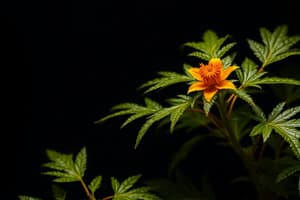Podcast
Questions and Answers
What is one of the therapeutic uses of turmeric rhizomes?
What is one of the therapeutic uses of turmeric rhizomes?
- Inducing sleep
- Sedative for insomnia
- Anti-inflammatory for joints (correct)
- Reducing blood pressure
Which one of these conditions can valerian rhizomes help treat?
Which one of these conditions can valerian rhizomes help treat?
- Hysteria (correct)
- Hepatitis
- Skin diseases
- Jaundice
Which of the following is an active constituent in valerian rhizomes?
Which of the following is an active constituent in valerian rhizomes?
- Bromides
- Curcumin
- Valepotriates (correct)
- Collagen
Turmeric is used to treat which of the following skin diseases?
Turmeric is used to treat which of the following skin diseases?
What is the function of curcumin in turmeric?
What is the function of curcumin in turmeric?
Valerian rhizomes contain how much volatile oil?
Valerian rhizomes contain how much volatile oil?
Flashcards are hidden until you start studying
Study Notes
Turmeric Rhizomes
- Turmeric has anti-inflammatory and antioxidant properties, making it useful for treating eye, joint, and prostate issues.
- It exhibits strong anti-hepatotoxic action, which is beneficial for hepatitis treatment.
- Turmeric is used to treat jaundice due to its ability to induce the flow of bile, breaking down fats.
- As a stomachic, it helps treat digestive disorders such as stomach upset, gas, and abdominal cramps.
- Turmeric is effective in treating skin diseases like scleroderma, psoriasis, and skin cancer due to its ability to reduce inflammation and improve collagen deposition.
- Curcumin, an active ingredient in turmeric, reduces inflammation and wound-healing time.
- Turmeric is used as a natural coloring agent for drugs, foodstuffs, and cosmetics.
Valerian Rhizome
Rezooma al-waleriyana
- Valerian rhizome is obtained from the rhizome, stolons, and roots of Valeriana officinalis.
- It belongs to the Valerianaceae family and is collected in autumn, dried at a temperature below 40°C.
- Valeriana contains not less than 15% of extractable matters.
Active Constituents
- Valerian contains volatile oil (0.5-1%), comprising esters, alcohols, terpenes, and sesquiterpenes.
- It contains valepotriates (epoxy-iridoids esters), a mixture of acevaltrate, didrovaltrate, and valtrate.
- Valerian also contains alkaloids (0.05-1%), such as valerine.
Therapeutic Uses
- Valerian is used as a sedative to treat hysteria and other nervous disorders, often in combination with other sedatives like bromides.
- It is effective in inducing sleep and treating insomnia cases.
- Valerian exhibits cytotoxic properties in vitro due to the presence of valepotriates.
- It has carminative properties, making it useful for treating digestive issues.
Studying That Suits You
Use AI to generate personalized quizzes and flashcards to suit your learning preferences.




